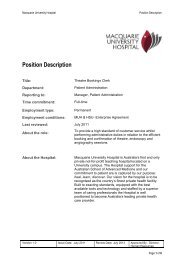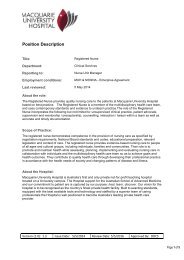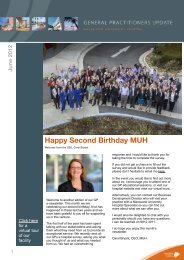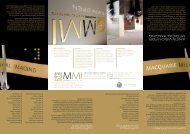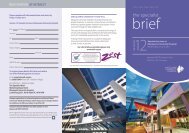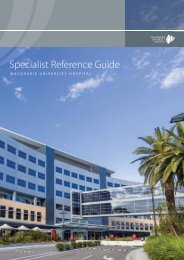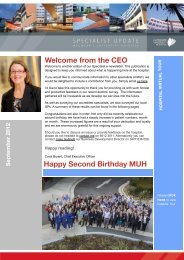Plenary Oral Presentations - Macquarie University Hospital
Plenary Oral Presentations - Macquarie University Hospital
Plenary Oral Presentations - Macquarie University Hospital
Create successful ePaper yourself
Turn your PDF publications into a flip-book with our unique Google optimized e-Paper software.
16 th International Meeting of the Leksell Gamma Knife ® SocietyMarch 2012, Sydney, AustraliaVA-119Gamma Knife Radiosurgery for dural Arterious venousFistula –the Vienna experienceBrigitte Gatterbauer, Harald Standhardt, Adolf Ertl, Josa Frischer, Engelbert Knosp, Klaus KitzDepartment of Neurosurgery, Medical <strong>University</strong> Vienna, Währinger Gürtel 18-20, 1Objective: Treatment strategies of dural arterio-venous fistula (dAVF) are diverse including embolisation,surgery, stereotactic radiosurgery and their combination. Spontaneous cure or regression ofsymptoms are reported but a therapeutic approach is warranted in patients presenting with retrogradecortical venous drainage, hemorrhage or aggressive neurological course.The aim of our study is to present GKN as a safe treatment possibility for dAVF.Methods: In a retrospective study we analysed patients presenting with dAVF and treated with GammaKnife radiosurgery (GKN) in our department between 2001 and 2011. 32 patients underwent 40 GKNprocedures. Patients presented different dAVF location most of them cavernous sinus (n=11) andtransverse sinus (n=7). The mean age of patients was 60,3 years (14,7 years SD). Detailed clinicalchart review was performed for all patients.The current clinical status of the patients was assessedvia a neurological examination, resulting in a mean follow up time of 3,3 years (2,2 years SD). Thepatient’s outcome was rated according to their residual symptoms. Descriptive statistical analysisincluded mean values and standard deviation (SD).Results: All patients presented with a broad spectrum of symptoms. In detail intracranial haemorrhage(5), ciliary injection (n=8), exophthalmia (n=9), chemosis (n=8), diplopia (n=6), headache (n=8),visual symptoms (n=7), tinnitus (n=7), elevated intraocular pressure (n=6) vertigo (n=2), ataxia (n=2),dysaesthesia (n=4). 16 patients underwent endovascular embolisation before and one after GKN,in six patients embolisation was tried. GKN was performed with 4, 8, 14, and 18mm collimators,respectively. The irradiated mean volume was 3,3 ccm (5,3 ccm SD). The mean prescription radiationdose was 19,1 Gy (1,7 Gy SD) and the central 37,5 Gy (6,6 Gy SD). In 6 patients a second in one athird GKN treatment was necessary.At the time of follow-up, neuroradiological imaging or clinical symptoms were improved substantiallyin 26% and disappeared completely in 73 % of patients.Conclusions: GKN is an effective treatment for dAVF in patients with a low risk of complications.In our series no further haemorrhage occurred, intraocular pressure normalised rapidly.77



